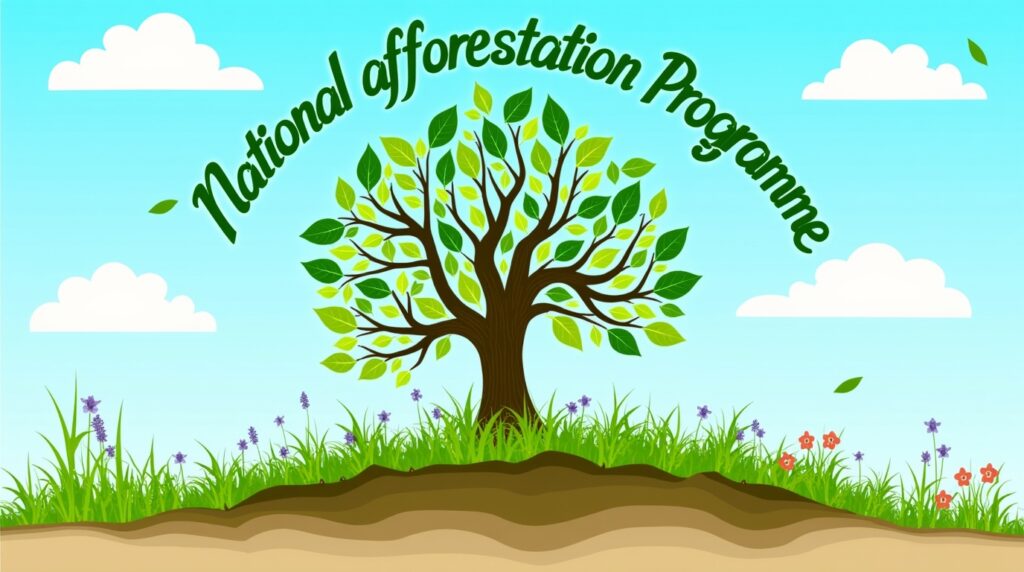Want to make a difference AND get funded for it? Dive into the National Afforestation Programme (NAP) and discover how you can help reforest India while potentially getting financial support. It’s easier than you think!
Trees Literally Grow on Money: Get Your Share of the National Afforestation Programme!
Okay, maybe trees don’t literally grow on money, but wouldn’t that be awesome? Imagine just throwing some rupees in the ground and watching a lush forest sprout up! While that’s not quite how it works, there IS a way you can get involved in reforesting India and potentially even get funded for it. Intrigued? Let’s dive deep into the National Afforestation Programme (NAP).
What is the National Afforestation Programme (NAP)?
Launched in 2000, the NAP is a flagship programme of the Indian Ministry of Environment, Forest and Climate Change. Think of it as a massive tree-planting initiative with a heart. It aims to restore degraded forests and bring greenery back to barren lands. But it’s not just about planting trees; it’s about empowering communities.
Here’s the cool part: NAP focuses on involving local communities in the afforestation process. This means villages, tribal groups, and even educational institutions can participate in restoring their own environments.
NAP’s goals are pretty ambitious:
- Increase forest cover
- Improve water catchment areas
- Prevent soil erosion
- Enhance biodiversity
- Provide sustainable livelihoods for local communities
Sounds pretty awesome, right? Now, let’s get to the juicy part – how YOU can get involved!
Who Can Apply for NAP Funding?
NAP isn’t just for big organizations. You might be surprised to know that a wide range of groups can actually apply for funding:
- Village Communities: This is the core of NAP. If your village has degraded forest land, you can form a Village Forest Committee (VFC) and apply.
- Tribal Communities: NAP recognizes the traditional knowledge and connection tribal communities have with forests, making them key partners.
- Educational Institutions: Schools, colleges, and universities can get involved in afforestation activities on their campuses or surrounding areas.
- Voluntary Organizations (NGOs): If you’re part of an NGO working on environmental conservation, you can definitely apply.
How Does the Application Process Work?
Ready to roll up your sleeves and get planting? Here’s a simplified breakdown of the application process:
- Form a Village Forest Committee (VFC): This is your core team. It needs to be a democratic body with elected representatives from the village.
- Prepare a Micro Plan: This is your blueprint for afforestation. It details the area you want to reforest, the types of trees you’ll plant, the activities involved, and how you’ll involve the community. Think of it as your green vision!
- Submit Your Proposal: Your VFC submits the micro plan to the Forest Department of your State. They’ll review it and provide guidance.
- Get Approval and Funding: Once your plan is approved, you’ll receive funding in installments based on the progress of your project.
Pro Tip: Reach out to your local Forest Department for detailed guidelines and application forms. They’re your best resource for navigating the process.
Making Your Application Stand Out
Want to increase your chances of getting approved? Here are some insider tips:
- Community Involvement is Key: Highlight how your project will actively involve the local community. NAP is all about empowering people.
- Sustainability is Crucial: Show how your plan ensures the long-term survival of the planted trees. Include strategies for protection, maintenance, and even potential income generation from the forest.
- Choose the Right Trees: Select tree species that are native to your region and suitable for the local climate and soil. Diversity is important too!
- Show Your Passion: Let your enthusiasm for environmental conservation shine through in your proposal.
Real-Life Success Stories
Need some inspiration? Check out these amazing examples of NAP in action:
- The Chipko Movement Legacy: In Uttarakhand, communities inspired by the Chipko movement have successfully used NAP to regenerate degraded forests, protect their water sources, and create sustainable livelihoods.
- Tribal Communities in Odisha: Tribal communities in Odisha have used NAP to revive traditional forest management practices, conserving biodiversity and improving their economic conditions.
- School Children Turning Green Thumbs: In many states, schools have actively participated in NAP, creating green spaces on their campuses and educating students about the importance of environmental stewardship.
Beyond Funding: The Ripple Effect of NAP
NAP isn’t just about the money (although that’s definitely a bonus!). It’s about creating a ripple effect of positive change:
- Environmental Benefits: Increased forest cover means cleaner air, improved water resources, and a healthier ecosystem.
- Social Benefits: NAP fosters community participation, empowers marginalized groups, and promotes environmental awareness.
- Economic Benefits: Sustainable forest management can create jobs, generate income, and boost local economies.
Are You Ready to Be a Part of the Solution?
We all have a role to play in protecting our planet. The National Afforestation Programme offers a fantastic opportunity to make a real difference. Whether you’re part of a village community, an NGO, or an educational institution, take that first step and explore how you can contribute to a greener India.
Remember: Every tree counts. Every action matters. Let’s work together to create a future where forests thrive and communities flourish.

